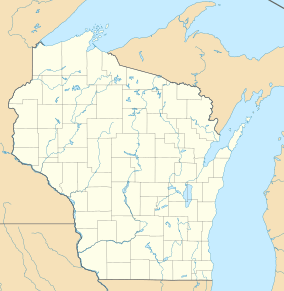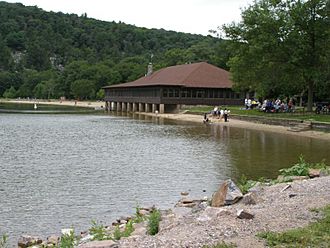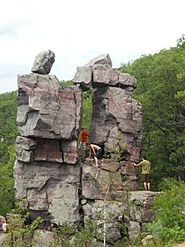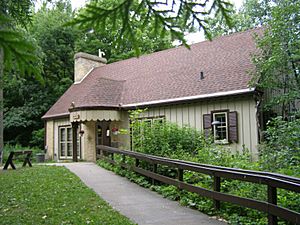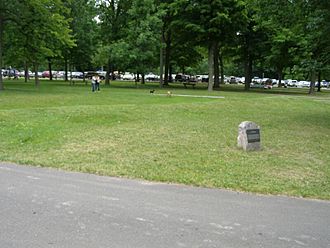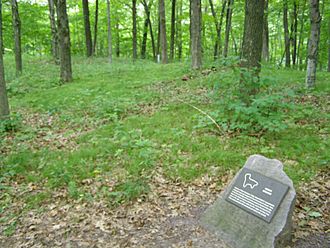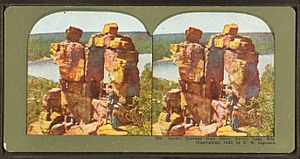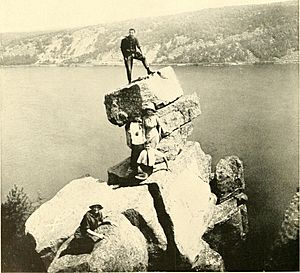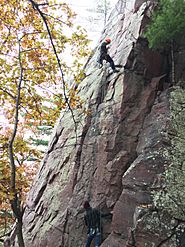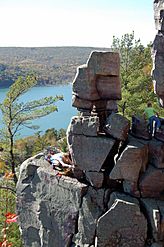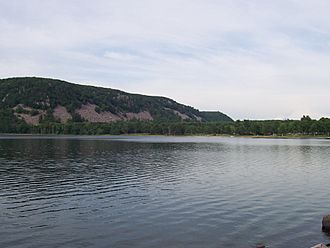Devil's Lake State Park (Wisconsin) facts for kids
Quick facts for kids Devil's Lake State Park |
|
|---|---|
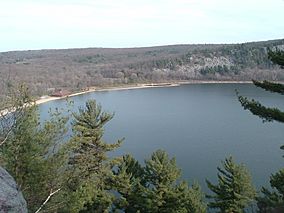
Devil's Lake from the West Bluff
|
|
| Location | Sauk County, Wisconsin, United States |
| Area | 9,217 acres (37.30 km2) |
| Elevation | 1,329 ft (405 m) |
| Established | 1911 |
| Governing body | Wisconsin Department of Natural Resources |
Devil's Lake State Park is the largest state park in Wisconsin. It is found in Sauk County, near the town of Baraboo. The park is about 35 miles northwest of Madison.
This park covers about 9,217-acre (3,730 ha) of land. It is famous for its tall quartzite bluffs, which are cliffs made of very hard rock. These bluffs rise about 500-foot-high (150 m) above Devil's Lake. The lake itself is about 360-acre (150 ha) in size.
Devil's Lake was formed by a glacier during the last ice age, about 12,000 years ago. The glacier left behind piles of rock and dirt called moraines. These moraines blocked both ends of a valley, creating the lake. The sand at the bottom of the lake also came from the glaciers.
You can find many cool rock formations in the park, like Balanced Rock and Devil's Doorway. There are also ancient Effigy mounds, which are earthworks shaped like animals. The park includes about eleven miles of the long Ice Age Trail.
Because it's so beautiful and close to the Wisconsin Dells, Devil's Lake State Park is one of the most visited parks in Wisconsin. Over three million people come here each year for day trips and camping. In the fall, the park's bright foliage makes it a very popular spot.
Parfrey's Glen, Wisconsin's first state natural area, is also managed by Devil's Lake State Park. It is located just east of the park.
Contents
Park History
The area around Devil's Lake was first settled by pioneers in the mid-1800s. By the early 1900s, it became a popular vacation spot. Wealthy families from Chicago and Madison would come to visit. The first hotel opened in 1866.
Devil's Lake State Park was officially created in 1911. At one time, there were five resorts here, with two built right on the west bluff. Today, none of these hotels remain. There were also many private homes along the lake, but only four are left. In the past, the lakeshore had water slides, lodges, and even golf courses. The park's current nature center is where a golf clubhouse used to be. By the 1940s, all the hotels had closed, and the park began to return to its natural state.
From 1934 to 1941, about 200 young men from the Civilian Conservation Corps (CCC) lived and worked in the park. They built many of the trails, buildings, and benches that people still use today.
In 1974, the National Park Service named the southern part of the Baraboo Hills a National Natural Landmark. The Nature Conservancy also called it one of the Last Great Places. This means it's one of only 77 such special places in the world.
Amazing Geology
The park is covered by a type of soil called Loess. The lake is surrounded by a mix of conifer and deciduous trees. The Baraboo Hills also have one of the biggest connected hardwood forests in the Midwest.
The park's geology is very interesting. Scientists have studied the area for many years. The lake itself is shaped like a rectangle. It is a little over a mile long and half a mile wide. It has many cliffs, unique rock formations, and different kinds of animals and plants. One cool feature is the large piles of broken rocks, called talus slopes, on three sides of the lake.
Glacial Moraines
Glaciers left behind large piles of rock and dirt called moraines. These moraines are important parts of the park's landscape.
- North Glacial Moraine: This moraine is found under the north shore area. The parking lots, food building, and picnic shelter are all built on top of it. This moraine forms the northern edge of Devil's Lake. It is about 80 feet (24 m) thick.
- Southeast Glacial Moraine: This moraine is located between the East Bluff and the South Bluff. The Group Camp is on top of this moraine. You can see it best from the Roznos Meadow parking area. This moraine is about 130 feet (40 m) thick.
Park Features
Visitor and Nature Centers
The park has a visitor center with a 3D model of the park. Both the north and south shores have places to get food and modern restrooms.
The nature center has exhibits about the park's geology and natural history. During the summer, you can join public nature programs. There are also evening programs on Saturday nights at the Northern Lights Amphitheater. The nature center displays old photos from the 1800s. It also shows examples of the plants (flora) and animals (fauna) found in the park.
Ancient Mounds
The park is home to several American Indian mounds. These were built by early North Americans. Across from the nature center, you can see effigy mounds shaped like animals, such as a lynx and a sparrow. Near the concession building, there is a linear mound, which is a geometric shape. These mounds were used as ancient burial sites. The nature center offers classes to learn about the history of these effigy mounds.
Fun Activities
Devil's Lake State Park offers many activities for visitors.
Hiking and Biking
The park has 41 miles (66 km) of hiking trails. Some are paved and easy to use, even for people with disabilities. Others are challenging and great for bouldering. The highest point on the trails is 500 feet (150 m) above Devil's Lake.
There are also bike trails. The park has eight miles of off-road bike trails. There's also a two-mile paved path for people with disabilities.
Camping
The park has three popular campgrounds with a total of 407 campsites. One of the campgrounds even has a sledding hill for winter fun!
Rock Climbing
The rock formations around Devil's Lake make it a top spot for rock climbing in the Midwest. The cliffs are made of quartzite, which is strong and safe for climbing. Other rocks in the region, like sandstone, are too crumbly.
Rock climbing has been popular at Devil's Lake since the early 1900s. There are many unique climbing "routes" and areas. Climbers use special names for the different bluffs to find specific climbs. The climbing here is known for its smooth, hard rock. Climbers use traditional safety methods and anchors.
It's important to be careful while climbing. There have been some accidents and rescues over the years.
East Bluff Climbing
The "East Bluff" has many climbing areas. These include "Doorway Mass" near the famous Devil's Doorway. There's also "Balanced Rock Wall" close to Balanced Rock. The "East Ramparts" area is very popular because it has many sheer, unbroken cliff faces perfect for climbing.
West Bluff Climbing
On the west side of the park, you'll find climbing spots like "Stettner Rocks" and The Cleo Amphitheatre. The Cleo Amphitheatre is home to a classic climb up a 25 feet (7.6 m) tall freestanding rock spire called "Cleopatra's Needle."
Wildlife
Devil's Lake State Park is home to many animals. You might see deer, raccoons, red foxes, coyotes, squirrels, and beavers. Sometimes, black bears, cougars, groundhogs, and wolves are spotted too. The park also has 115 different kinds of birds. The timber rattlesnake also lives here, so be aware.
Climate
|
||||||||||||||||||||||||||||||||||||||||||||||||||||||||||||||||||||||||||||||||||||||||||||||||


